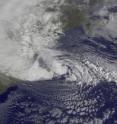UI researcher predicts more intense North Atlantic tropical storms
Tropical storms that make their way into the North Atlantic, and possibly strike the East Coast of the United States, likely will become more intense during the rest of this century. That's the prediction of one University of Iowa researcher and his colleague as published in an early online release in the Journal of Climate, the official publication of the American Meteorological Society.
The study is a compilation of results from some of the best available computer models of climate, according to lead author Gabriele Villarini, assistant professor of civil and environmental engineering and assistant research engineer at IIHR-Hydroscience & Engineering, and his colleague Gabriel Vecchi of the National Oceanic and Atmospheric Administration, Princeton, N.J.
"We wanted to conduct the study because intense tropical cyclones can harm people and property," Villarini says. "The adverse and long-lasting influence of such storms recently was demonstrated by the damage Hurricane Sandy created along the East Coast."
The study itself examines projected changes in the North Atlantic Power Dissipation Index (PDI) using output from 17 state-of-the-art global climate models and three different potential scenarios. The PDI is an index that integrates storm intensity, duration, and frequency.
"We found that the PDI is projected to increase in the 21st century in response to both greenhouse gas increases and reductions in particulate pollution over the Atlantic over the current century. By relating these results to other findings in a paper we published May 13, 2012 in the journal Nature Climate Change, we found that, while the number of storms is not projected to increase, their intensity is," he says.
"Moreover, our results indicate that as more carbon dioxide is emitted, the stronger the storms get, while scenarios with the most aggressive carbon dioxide mitigation show the smallest increase in intensity," he says.
Source: University of Iowa
Other sources
- More intense North Atlantic tropical storms likely in the futurefrom Science DailyFri, 30 Nov 2012, 22:30:50 UTC
- Researcher predicts more intense North Atlantic tropical stormsfrom PhysorgFri, 30 Nov 2012, 21:00:52 UTC
